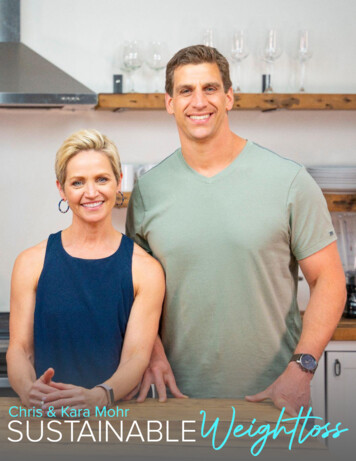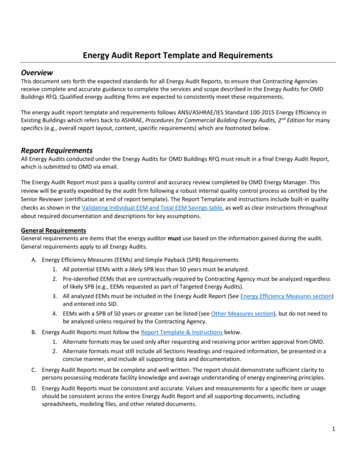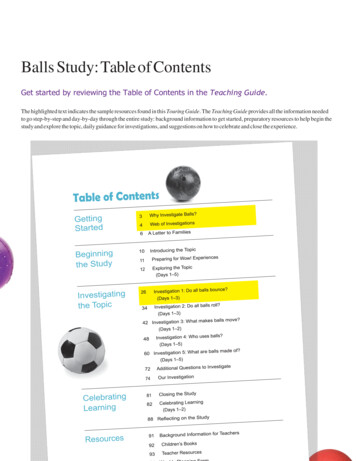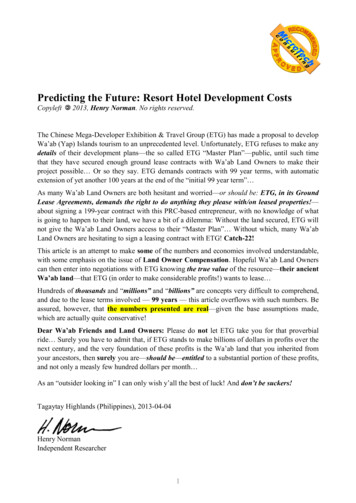
Transcription
TABLE OF CONTENTSAbout The InstructorsWelcome Message3-45Step 1: Set Your Weight Loss Goals6-7Step 2: Track Your Progress8-10Step 3: Routines For Successful Weight Loss11-14Step 4: Prepare Healthy Meals15-18Step 5: Move More19-20Step 6: Navigate Pitfalls21-22Step 7: Hold Yourself Accountable23-24Contract For My Health25Track Your Weekly Progress26-32Mix and Match Recipes33-362
ABOUTChris Mohr is a registered dietitian, nutritionspokesperson and consultant to numerousmedia outlets and corporations. He holds aPhD in exercise physiology, is a consultingsports nutritionist for the WWE, and formerlyserved as the consulting Sports Nutritionistfor the Cincinnati Bengals. His expertise hasoffered him the opportunity to speak at theWhite House, the CIA and to audiences inover 10 countries and almost all 50 states.He often appears on TV as a nutritionalguest expert, including an appearance withChef Emeril Lagasse, CBS’s ‘The Talk’ andanother on the Montel Williams Show. Hewas the nutrition consultant and expert forthe NY Times Bestseller, “LL Cool J’sPlatinum Workout” and worked closely withFitness Celebrity Denise Austin & MarioLopez, to write the nutrition sections for theirbooks.CHRISTOPHER MOHRPHD RDDr. Mohr was on the Advisory Board forMen’s Fitness Magazine and has written over500 articles for consumer publications, suchas Men’s Fitness, Men’s Health, Muscle andFitness, Shape and most other fitnesspublications. Dr. Mohr has Bachelor andMaster of Science degrees in Nutrition fromPennsylvania State University and Universityof Massachusetts, respectively.3
ABOUTKara Mohr is a performance coach andinternationally recognized dynamic keynotespeaker who is known for her expertise andexperience in the areas of behavior change,exercise and motivation. For over 25 years,Kara has been using her engaging style toinspire teams and individuals to transformtheir understanding of personal energy andpurpose. Her mission is to be present andcreate meaningful connections with others.Her goal is to inspire others to become fullyalive in their lives.KARA MOHR PHD,EXERCISE PHYSIOLOGISTKara began her career in academics and hasheld faculty positions at the University ofLouisville, the University of Pittsburgh andEastern Michigan University. At theUniversity of Pittsburgh, she was also theassistant director of the Physical Activity &Weight Management Research Center, aNIH-funded research center that focuses onthe role of exercise in the prevention andtreatment of overweight and obesity.Dr. Mohr earned her BS in psychology fromPennsylvania State University, and her MSand PhD in exercise physiology from theUniversity of Pittsburgh. She lives inLouisville, KY. In her free time you can findher cooking with her husband and havingkitchen dance parties with her twodaughters.4
INTROWELCOME TO SUSTAINABLE WEIGHT LOSSIf you’ve ever tried losing weight, you know what a challenge it can be. Diets thatover-promise miracle results and often contain conflicting information can leaveyour head spinning and feeling discouraged.This program takes a different approach by making weight loss flexible andsustainable for anyone – because this program adapts to you!7 Steps to Sustainable Weight Loss is all about the fundamentals of how weight lossworks, and how to personalize it to your lifestyle and goals. The program is brokendown into 7 clear behavior-based steps, focused on core strategies that can workuniversally for anyone.Weight loss is a marathon, not a sprint. Drs. Chris and Kara Mohr will be yourguides and here to support you along the way.MEET THE 7 STEPS OF SUSTAINABLE WEIGHT LOSS1.Set your own personalized, healthy, and realistic goals2.Track your progress3.Change your behaviors and set up routines for success4.Focus on healthy eating5.Get more exercise and movement6.Learn to navigate common weight loss pitfalls7.Hold yourself accountable5
STEP 1SET YOUR WEIGHT LOSS GOALSTime to set your weight loss goals! Healthy andsustainable weight loss should be around1-2 lbs per week. Another way to measure yourgoal besides weight is to find out your bodyfat percentage, and aim to lose about 1% ofyour total body fat per month.But it’s about more than just the number on the scale here. Wellbeing, includingweight loss, is a holistic pursuit. We want you to become the healthiest, fittest,strongest version of yourself, not just a lighter version. We want you to carryyourself proudly and be comfortable with your body. Your goal should also includequalitative benchmarks, like being able to tackle a hike or other activities you wantto do, but that are out of reach right now.CALORIE DEFICITThere’s one overarching principle that we need to follow if we’re going to loseweight and keep that weight off. We need to be in a calorie deficit. In other words,we have to eat fewer calories than we expend. Calories in, calories out.One pound is equal to approximately 3,500 calories. That means to lose 1 pound,you have to make sure your net intake decreases by 3500 calories. This couldmean eating 3,500 calories less over the course of a week, or it could meanexpending 3,500 more calories through exercise. More likely it should be acombination of both, but this is where you can adapt it to your own lifestyle andhabits. Calories are important, but there’s more to it than just calories alone.we’llexplore this in the other steps.SET THOSE GOALS!Sticking to 1-2 lbs a week, consider where you want to be by the end of thisprogram. Over the eight weeks that this program lasts, that could be about 8-16 lbs,even with imperfect, but consistent, progress. If you want to lose more than that,you can repeat this program or continue through 10, 12, or more weeks on yourown, using the steps and tools you’ll learn throughout the program.6
STEP 1SET YOUR WEIGHT LOSS GOALS (CONTINUED)This table will help you see how many weeks it will take to reach your goal weightusing our 1 or 2 lbs. a week rule of thumb. If you have more weight to lose or canreally commit to consistent habits, you can achieve 2 lbs. a week. But if you’re notsure, we recommend starting with a goal of 1 lb. a week, and you can adjust it laterif you feel ready to do more. Keep in mind that these numbers are averages, not asteadfast rules.Total weight loss1 pound per week2 pounds per 53.757.5weeksmonthsweeks ksmonthsweeks 3monthsMY WEIGHT LOSS GOALSMy total goallbs. / weekMy timeline7
STEP 2TRACK YOUR PROGRESSEveryone's a little different and there’s not a one-size-fits-all approach to trackingprogress, but finding a way to track your progress that works for you will make youmore likely to succeed. Let’s look at a few of the options so you can find a flexibletracking method that works for you.TRACKING APPSThere are endless app options for tracking food and calories – both what you eatand what you burn through exercise. For many people, keeping track of meals orcalories is a key to success. It can gamify weight loss, or make it feel more like acompetition with yourself, which can be motivating.It can also help you get more clarity around what you’re eating, how much you’removing, and whether you’re on track to hit your goals – and this can help you holdyourself accountable.HAND PORTION SIZE GUIDEIf that’s too much info, stress-inducing, or just too high-tech, there are lots of otherways to measure your intake and output too! Your hands are actually a great toolfor estimating healthy meal portions, because they’re relative to you and your bodysize. Here’s how to build your plate:PRODUCEPROTEINGRAINSFATTwo HandfulsOne PalmfulOne FistfulThumb Size8
STEP 2TRACK YOUR PROGRESS (CONTINUED)ACTIVITY TRACKINGActivity matters too. Many of the same apps that trackcalories will also track your activity or allow you to logactivity, so you don’t need dozens of different appsand tracking devices to hold you accountable.Did you know that Grokker will sync with your AppleWatch, Fitbit, or Garmin to log activities from thosedevices as Wellness Minutes on Grokker?Another great activity tracking feature is Grokker Streaks!Every day that you watch a Grokker video, sync anactivity from a wearable, or even manually log an activity,you’ll get a badge on your calendar for each day in a row.Seeing how long you can build your streak is a greatway to track your progress and stay motivated! Did youknow that some Grokker users have built 100-day streaks?!WEIGHING YOURSELFThe scale can be one tool in the toolbox, but it’s far from the only tool as it doesn’ttell the complete picture of what’s going on.Weight loss isn’t linear like a slide, it’s more like a roller coaster. Scales don’taccount for normal and expected fluid shifts or daily changes.We’re not naysaying the scale; we just don’t want you to use it as your only tool.Weighing-in once per week at a scheduled time and with similar amounts of clothescould be enough to check your progress.If weighing yourself daily is a helpful reminder to stay on track, by all means do so!But know that being a pound heavier than the day before doesn’t mean you took abig step backward. You have to look at your weight trend over a longer time periodthan one day to the next.9
STEP 2WEEKLY MEAL CHARTYou can use this chart to log all your meals and snacks, OR you can simply log thehighlights and red flags. By tracking your meals without counting the calories,you’ll still build an awareness of whether you’re on the right track and where youneed to ESMONBreakfast10
STEP 3ROUTINES FOR SUCCESSFUL WEIGHT LOSSTo successfully lose weight, no matter your approach, you’ll have to make somechanges to your current routines and stick to them. So step 3 in your weight lossjourney will help set you up for some of the specific new routines around nutritionand movement we’ll help you establish.By focusing on small habit changes, you can make significant weight loss progressboth by increasing your positive habits and decreasing your less healthy ones. Let’sidentify a few habits you want to focus on.Starting with your better habits, what are a few that you’re proud of that you want tokeep? For example, maybe you go out to water your garden every day in themorning. You might not think of that as part of a weight loss program, but if youdidn’t do that it would be less movement every day and less calories expended.Write down a few of your good habits that contribute to weight loss, no matter howsmall.11
STEP 3ROUTINES (CONTINUED)Now let’s identify some of your habits that aren’t quite as good. You probably knowwhat many of them are because they’re guilty pleasures like bingeing your favoriteTV show with a glass of wine or your favorite snack in hand. There’s nothinginherently bad about this, but the part we might not pay attention to is how manyglasses of wine or bowls of snacks we’ve had.Other habits might be flying more under your radar. For example, maybe you alwayseat a late lunch because you get lost in your work, and struggle to make healthylunch choices because you’re so hungry. It’s these little things, stacked on oneanother, that may be hindering your long term success.Write down these habits that you’d like to eliminate or improve and we’ll return tothem later. In order to understand the underlying reasons behind them, and how youcan change them for the better, we need to understand the process of how habitsare formed in the first place.12
STEP 3ROUTINES (CONTINUED)Habits are formed through a cycle of reinforcement called Cue, Craving, Response,and Reward. Here are the basics:CUE: If you drink a glass of wine at the end of the day, your cue may be the time ofday that you drink the wine, the feeling of being mentally done with your workday,or even seeing the countertop where you pour the wine. The more cues we have,the more likely we are to do the action.CRAVING: This is the motivation behind the habit; what moves you to act. In thewine example, perhaps what you really crave is the connection and time with yourspouse; and drinking wine together is simply the way you make that happen.RESPONSE: This is the actual habit you perform when you experience a cue andhave a craving for something; drinking wine in this example. Your response is tied toyour experience, interests, availability, and your mood.REWARD: For most of us, we are rewarded when we satisfy our craving. Our brainlikes the satisfaction of removing the discontent. And if the reward also has otherbenefits, it’s more likely we’ll repeat this cycle over and over.13
STEP 3ROUTINES (CONTINUED)Now that you understand this cycle, you can use it to your advantage: Increase cues and set up rewards for behaviors you want to make intoinstinctual habits. Reduce cues and cravings for behaviors you want to avoid – or in other words,put up some roadblocks to make bad habits harder.Take a few minutes to reflect on the habits you wrote down earlier. For your healthyhabits, what are some common resistance points that sometimes cause you to flakeout of them? What could you do to make them easier to do consistently?With the less healthy habits that aren’t serving you well, what makes them so easyor makes you do them too much? Are there any little roadblocks that might makeyou less likely to do them?14
STEP 4PREPARE HEALTHY MEALSIt’s time to start talking specifics! Foods to choose, foods to swap, and a morein-depth look at estimating portions using your hands, rather than counting calories.PRODUCEStudies show that eating just a single additional piece of produce each day can cutthe risk of a heart attack or stroke by up to 40%! All produce is incredible for you.None cause you to gain weight. None are unhealthy or have dangerously highamounts of sugar. Not even bananas, mangoes, melons, or carrots, which sadlysometimes get a bad wrap.A good rule of thumb is to aim for a 2:1 amount of veggies to fruit; so for every 2servings of veggies, have 1 of fruit. We’re not going to get too particular here;there’s no concern of piling that produce high.Research out of Penn State has found that a major benefit of eating more produceis greater weight loss, when compared to those who eat less produce. It has to dowith the volume of the food. Fruit and veggies are full of water which makes themhigh volume, making them more filling compared to many other foods. They’re alsopacked with nutrients so they’re filling you up and nourishing you without addingweight. That’s why fruits and veggies should be a major part of meals and snacks,which is why we shared the two handfuls or half plate rule.PROTEINProtein should take up about ¼ of your plate, or one handful. The thickness andsize of your palm is a proper serving of protein.Meat isn’t the only source of protein, and protein doesn’t have to just come fromone source per meal. Nuts, whole grains, beans, tofu, eggs, and dairy all containhigh amounts of protein. Diversifying your protein sources can help you cut downon red or fatty meats and help you lose weight faster, while still getting a greatbalanced meal.15
STEP 4PREPARE HEALTHY MEALS CONTINUEDCARBSThe last part of the plate is the grains. There are an endless amount of options fromrice to quinoa, pasta, farro, oats, bread and more. Like the other food groups, therecan be a big difference in the quality. Opt for unprocessed grains, or grain productsthat say “Whole Grain” or “Whole Wheat” on them. Whole grains include the partsof the actual grain where all the nutrients are, not just the starchy filler part that’sfound in overly processed grains. Nutritious whole grains will satiate you better andgive you more nutrition, and help you avoid taking in too many calories to feel full.LIQUID CALORIES & HYDRATIONLiquids can play a big role in your overall success with reaching your goals. Onaverage, people drink about 400 calories per day from liquid alone; soft drinks,energy drinks, alcohol, juice, etc. Now this isn’t to say never drink a single calorieagain; however, we need to be mindful about consumption, and here’s why:Research shows that the calories you drink don’t equate to cutting backon eating other calories. Liquid calories are add-ons to your daily intake,and those extra calories can add up quickly.Hydrate with low or no-calorie liquidslike water, seltzer, flavored waters, andless frequently, low fat/unsweeteneddairy drinks or unsweetened non-dairybeverages as well. Keep in mind thatcoffee and tea are also amazing andhave unique benefits themselves, butthere is a caveat; sugar, honey or anyother sweetener, those add up as well.16
STEP 4PREPARE HEALTHY MEALS (CONTINUED)SNACKINGSo now that we’ve covered meals with the plate breakdown, what about snacks?Rather than answer the “should I snack?” question, ask yourself instead, “when Isnack, what should I choose?”A balance of protein and produce makes a fantastic snack. In real-food terms, thatmeans things like fruit and cheese, veggies and hummus, a handful of nuts, beefjerky and fruit, fruit or veggies alone, veggies and guacamole.One thing to be cautious of is overdoing snacks. It’s easy to do because caloriesadd up quickly. Preparing healthier snack options ahead of time can help this.Making healthy snacks ready to eat and just as accessible as the ultra-processedoptions makes it much easier to make the right snack choice. Cut up fruits andveggies ahead of time. Leave a washed apple or nuts on your work desk.MEAL PLANNINGNow that you know a little more about what kinds of foods to focus on, how do youfollow through on eating them consistently? Because your weight loss successcomes from consistent work, and the key to consistency with nutrition is planning.First, map it out with a weekly menu. You can find a simple template on the nextpage. Once you’ve that filled out, it’s time to create a shopping list.This menu is different from the meal tracking table in step 2, in that this is whatyou’re planning to have, not what you ultimately did have. Plans change and thingshappen, so this will allow you to compare where you might have gotten off course.Having your meals planned out and shopped for cuts down on decision fatiguewhen a meal time is approaching with no yummy and healthy options. When youplan ahead, you can plan meals that are BOTH yummy AND healthy.17
STEP 4WEEKLY MENU EDTUESMONBreakfast18
STEP 5MOVE MOREANY MOVEMENT IS GOOD MOVEMENTExercise has many more benefits than just what you see on the scale, like how youfeel. Your energy level and ability to do the activities you want can be equally, if notmore important markers of your progress, even though they’re a little more abstractthan the scale.Any movement is a huge step in the right direction! Any movement is always betterthan no movement, no matter how simple or how minimal. Everyone is in a differentstarting place and regardless of where yours is, the fact that you’re at that line iswhat matters. The more you move, the easier it is to keep moving. Maintain themomentum.When we think about movement, it’s important to think about reducing resistanceto move. It does take effort, so until it’s a regular part of your routine, there’s alwaysan easier option. Can I go to the restroom next to my office or should I go to thefarther one for a little movement break? Can I add a healthy reward after a workoutto make it more enticing?START SMALLIt’s easy to think that to lose weight, you have to train for a marathon, lift weights allday, and do extra Grokker videos. None of that is true.Meet yourself where you are now. Rather than thinking you have to begin byrunning 5 miles from day 1, maybe a better goal would be walking 5 minutes everyhour. From there you can build on it and switch to running or simply increase thetime from 5 minutes to 10 minutes.19
STEP 5REDUCE RESISTANCE TO MOVEMENTResistance to exercise can come in the form of work, schedules, laundry; reallyanything that makes it hard to find time or motivation for more activity. So how dowe move that out of the way?One way to cut through some of that resistance is to build movement into your dailyroutine. Schedule movement like any other important meeting or appointment thatyou’d surely never miss. Movement has to get the same priority.GET MOVING ON GROKKERYou can get a great start with some of our favorite Grokker videos. We’ve includeda variety of short stretch breaks and longer workouts for when you’re ready to pushyour boundaries.20
STEP 6NAVIGATE PITFALLSWe’ve taken you through thefoundational steps of weight loss so far:setting clear and achievable goals, trackingyour progress, creating healthy habits to enableweight loss, and how to approach nutrition and exercise.Every weight loss journey has some roadblocks and setbacks, soStep 6 is being ready for them and learning how to get past them and persist.It doesn’t matter what the trigger “event” might be, the outcome is usually the same.We beat ourselves up, feel like a failure, and stumble getting back up. Rather thansticking to our original path, we fork off down the “I’ll never be successful at this”path.BE FLEXIBLE WITH YOURSELFIf you hit a roadblock, remember that you’re not alone in this. What is so important tounderstand is one event, one night that you get off track will not derail your successin the longer term. As a matter of fact, it’s more how you respond that will determineyour success. What you do most of the time is more important than what you dosome of the time.Can you say that out loud? “What I do most of the time is more important thanwhat I do some of the time!” Jot that one down on a sticky note and keep it on yourbathroom mirror to remind you.AVOID TRIGGERSHow can you avoid pitfalls in the first place? Consider this strategy - when youconfront situations that you know may be a trigger or potential pitfall for you,CHANGE your environment to remove yourself from common triggers.For example, maybe you have a work event that you can’t get out of, but could youskip the drinks at that event? Or if you have trouble sticking to your list at thegrocery store, how about ordering groceries online instead? Take a minute to thinkabout how you can avoid some of your triggers with a clever workaround.21
STEP 6NAVIGATE PITFALLS (CONTINUED)MAKE TIME FOR WEIGHT LOSS HABITSMaybe your trigger isn’t around nutrition, but rather exercise. A common fitnesspitfall is not planning for it early enough in the day, or not planning for it at all andhoping that it will just “happen” when the time is right. But here’s the truth; exercisewill almost always take a back seat to life, so when there’s laundry to do, anotheremail to send, or the Dad taxi service is needed to take your kids to various events,exercise won’t take precedence.A mentor once told us that with so many demands each day, he first started blockinghis calendar and writing “meeting” at noon. When others saw it, they didn’t questionthat he was busy with a meeting at noon each day. The truth was he did have ameeting at noon; it just wasn’t business related and was actually with his tennispartner.In order to make physical activity happen, you have to own it as a non-negotiable.You need systems to not let other activities or people get in the way of your decisionto move.Time is a common pitfall when it comes to fitness, but applies equally to nutrition,routines, or any other step. If you don’t make time for preparing healthy meals, ordon’t make time to plan and shop in the first place, it’s likely life will get in the way.When you encounter a pitfall, be flexible with yourself. You will have some setbacks,and maybe even whole weeks where the scale doesn’t move like you’d hoped.Weight loss is not linear. Yes, it’s easy to stick to a plan when things are goingswimmingly; it’s when the water gets a little choppy when your habits will be trulychallenged and you’ll ultimately find your path or get pushed back by the current.Don’t give up! Welcome the challenge and you will still get there over time bysticking to your goals and habits.22
STEP 7HOLD YOURSELF ACCOUNTABLEStep 7 is all about sharing. And bysharing, we mean finding ways to beaccountable by sharing what you’redoing with your friends or family.PHONE A FRIENDThis is a story about one of our client’s Julie. She was in one of our weight lossprograms and at the start, told us her only movement was reaching in and out ofthe drive thru window to grab her bag of food, but she planned to be our starparticipant.Week after week she would come to our center for our weekly lesson and to checkin with us. She was doing great and we learned during our time together that sheenlisted a friend from her neighborhood to walk with her every day. They normallytalked on the phone every day, but decided that rather than sit and talk on thephone, they would meet to walk and talk.Their daily walk started with her just walking up the block to her friend’s house andthen sitting on the patio talking, because she physically couldn’t do any more thanthat at the time. But she progressed and continued around the block and then thenext block and the next after that, until several months later and they were walkingconsistently for sometimes 60 minutes every day!Fast forward and Julie continued to do really well because she didn’t think of this asexercising, she was simply connecting with a friend with movement as a sidebenefit, and she was able to do it so consistently because she was beingaccountable to someone else.OTHER WAYS TO FIND ACCOUNTABILITYMaybe you have a friend like Julie who makes a great accountability partner, but ifnot, there are lots of other ways to find support and accountability too. In this digitalage there are great opportunities to hold yourself accountable with online groupsof social media.Continued on next page.23
STEP 7HOLD YOURSELF ACCOUNTABLE (CONTINUED)If you love posting pictures of your vacations, pets, kids, whatever, why not expandthat to include posting your meals? Posting stories about your weight loss goalsand your ups and downs along the way are a helpful method of accountability andfinding community support. There’s a reason so many people post before and afterpictures after all, and you’re likely to get lots of encouragement from friends andfamily that can help you stay motivated and accountable.Finding a group of like-minded people who are also losing weight, even if you don’tknow them personally, is a great source of accountability for many people. You canfind online weight loss groups, or you can even create your own by posting belowthis video or in the Grokker forums. We are in the Grokker community as well and inthere responding to questions and giving support, so we’re certainly a great option.The bottom line is there are lots of others out there searching for weight lossaccountability just like you, you just have to seek them out.SELF CONTRACTIf you’re more introverted or just don’t feel comfortable sharing your weight lossjourney, you can still hold yourself accountable. There is one person in this worldwho is your best accountability partner – you!A great method of accountability is to create and sign a contract with yourself.Check out the template you can use on the next page. Making a promise toyourself to put your own health and goals first is a great way you can hold yourselfaccountable. It’s a powerful step that makes it that much harder to back-burner yourweight loss when life gets in the way, and that much more likely you’ll feelresponsible to see it through to the end.No matter how you choose to personalize this step of your weight loss journey,what’s really great about accountability is staying focused on the bigger picture. Setbig goals, make smaller, actionable steps to get there, and hold yourselfaccountable to follow through on those steps!24
STEP 7CONTRACT FOR MY HEALTHThis contract is your extra commitment to yourself, to make the following behaviorsinto long-term commitments. It’s an opportunity for you to sit down and beintentional about the behavior you want to adopt and stick to.I, , am responsible for my own health andwellbeing, and hereby commit to following my weight loss goals.These are the things I will do moving forward, to achieve my goals:These are the behaviours I will limit in the future:SignedDate25
WEEK 2CHECK IN ON YOUR GOALSEach day we make steps, and sometimes missteps. But keeping your goal top ofmind will help you stay focused and make progress in the right direction.Use these remaining pages to check in with your goals and progress each week.Each week and each day you should be practicing all 7 of the steps in this program,but for week 2 we’re taking a look back at our goals from the first video.Are you on track? If so, fantastic! If not, also fantastic, because we’re confidentyou’re still working to achieve your goals, but maybe the progress has been slowerthan you hoped. But that’s OK!Reflect on what you wrote as your goal to start. Do your first goals still resonatewith you? Are they serving you well, or is anything not sitting quite right with you?Use this space to reflect on your goals and progress thus far.CURRENT WEIGHTGOAL WEIGHT26
WEEK 3KEEP UP YOUR TRACKINGEvery day on your weight loss journey may not feel like this amazing leap forward,but you will keep improving as long as you keep showing up for yourself andmaking a consistent, honest effort. Maybe it’s physical. Maybe it’s emotional. Butshowing up for you is the best thing you can do in an effort to succeed andcontinue making progress.Reflection time. What methods have you settled into consistently for tracking?Have you weighed yourself? Been tracking your meals or jo
books. Dr. Mohr was on the Advisory Board for Men's Fitness Magazine and has written over 500 articles for consumer publications, such as Men's Fitness, Men's Health, Muscle and Fitness, Shape and most other fitness publications. Dr. Mohr has Bachelor and Master of Science degrees in Nutrition from Pennsylvania State University and .










